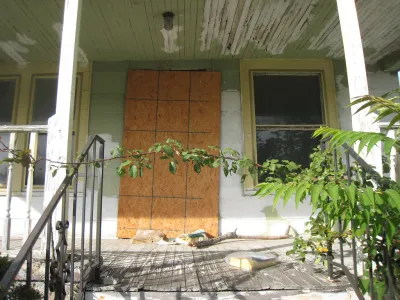Mobile, Alabama, has changed the way it deals with blight, and the results have been substantial.

Hana Schank explores the legal and policy changes in Mobile, Alabama, that have helped the city turn around a blight problem that was consuming neighborhoods, exacerbating segregation, and hindering economic development.
The city's innovation team, a project funded by Bloomberg Philanthropies, and a mayor who made blight a priority have been instrumental in altering how blight is defined, identified, and addressed as well as the legal underpinnings related to ownership of properties.
The innovation team started identifying "blight zones," instead of individual structures, and developed an index that has helped the city’s blight task force more effectively pinpoint properties where action is needed. The city also stopped issuing fines and instead started giving owners the opportunity to make repairs. If they failed to do so, the city would take on the task and then place a lien on the property for the costs.
Schank details the history of the onerous state property laws that made it difficult for the city to get new owners into repaired homes. "Last year, prompted in large part by the Mobile innovation team’s work, the Alabama state house passed HB430, which allows cities to use municipal liens, rather than tax delinquency, to claim ownership of a property."
The number of blighted properties in Mobile has dropped by almost half in four years, says Schank. "This is the story of how one city reduced blight, but it is also the story of what happens when cities think differently about how to solve their problems, when politicians are willing to embrace policies that might not line up with the party line, when city workers look beyond band-aid solutions."
FULL STORY: Blight is eating American cities. Here’s how Mobile, Alabama, stopped it

National Parks Layoffs Will Cause Communities to Lose Billions
Thousands of essential park workers were laid off this week, just before the busy spring break season.

Retro-silient?: America’s First “Eco-burb,” The Woodlands Turns 50
A master-planned community north of Houston offers lessons on green infrastructure and resilient design, but falls short of its founder’s lofty affordability and walkability goals.

Delivering for America Plan Will Downgrade Mail Service in at Least 49.5 Percent of Zip Codes
Republican and Democrat lawmakers criticize the plan for its disproportionate negative impact on rural communities.

Test News Post 1
This is a summary

Test News Headline 46
Test for the image on the front page.

Balancing Bombs and Butterflies: How the National Guard Protects a Rare Species
The National Guard at Fort Indiantown Gap uses GIS technology and land management strategies to balance military training with conservation efforts, ensuring the survival of the rare eastern regal fritillary butterfly.
Urban Design for Planners 1: Software Tools
This six-course series explores essential urban design concepts using open source software and equips planners with the tools they need to participate fully in the urban design process.
Planning for Universal Design
Learn the tools for implementing Universal Design in planning regulations.
EMC Planning Group, Inc.
Planetizen
Planetizen
Mpact (formerly Rail~Volution)
Great Falls Development Authority, Inc.
HUDs Office of Policy Development and Research
NYU Wagner Graduate School of Public Service




























